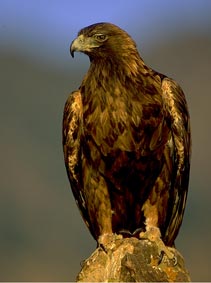Nature: Laying the golden egg

Golden Eagles have had trouble breeding since their re-introduction to Ireland but they'll soon get the hang of it, says Éanna Ní Lamhna
Golden eagles were a part of our native fauna from ancient times. A cursory look at place names in any maps of mountainous counties will reveal a myriad of places named after the eagle – or the iolar as it is called in Irish. Eagle's Hill in Kilkenny, the Eagle's Nest on Slieve League in Donegal, Eagle's Hill in Kerry, Coumaniller in Tipperary and Eagle's Rock in Leitrim to name but a few. It bred on rocky mountain cliffs in eyries and fed on hares, rabbits, crows and fox cubs, swooping down and carrying them off in its powerful talons. It wasn't above eating carrion and would eat dead lambs, discarded afterbirths and such that would be lying out on the mountain sides. Farmers believed it carried off weakly lambs and perhaps they did – nature being red in tooth and claw.
It was considered to be the enemy of the farmer who tried to get rid of it by putting out poisoned carrion for it to eat, robbing its nests and shooting birds on sight. Certainly the Donegal eagles did themselves no favours when the leg of a man who had died of hunger during the famine was found in its nest. The whole nest was burned out of it by the outraged neighbours. And so it came about that golden eagles became extinct in this country in the first decades of the 20th century – in 1912 in Donegal and in 1914 in Mayo.
Things rested so for almost a hundred years. In 2001 it was decided to re-introduce the golden eagle as a millennium project. They had never died out in Scotland so it was here that the stock closest to the original Irish birds lived.
Eagles lay two eggs, which hatch out in sequence so one of the birds in the nest is older and bigger than the other. The biggest chick is fed first and in times of plenty there is food for the second smaller one too. In times of food scarcity only the larger one is fed so that at least one will survive – no room for sentiment here. So it was possible, under licence, to collect the second chick from nests in Scotland – chicks that might not survive there anyway – and introduce them here in Glenveagh National park in a carefully managed breeding programme currently funded by the National Parks and Wildlife Service and the Heritage Council.
Six chicks were brought in 2001, eight in 2002, 11 in 2003, 10 in 2004, seven in 2005 and four in 2006 – giving a total of 46. It is thought a population of 60 birds is needed to have a viable population.
The project will be considered successful when the eagles breed, build nests, lay eggs and successfully rear young. As all these birds were brought here as chicks, they have not observed breeding in the wild. Nor have they had a chance to mix with older experienced birds. At the moment they are fumbling inexperienced teenagers – not quite sure what they are supposed to be doing – but up for it nonetheless.
One pair got together in 2004 and held a territory – the equivalent of going steady I suppose. In 2005, two pairs were going out together and one pair got as far as building a nest and laying an egg. The egg never hatched and was infertile but such breeding behaviour in such young birds was seen to be very encouraging.
This year, four pairs of eagles with love on their minds were observed. One of these pairs had laid the infertile egg in 2005. While they constructed two nests near to each other they laid eggs in neither nest and did not breed. The second pair were an item since 2005 and they built a nest this year and laid an egg. The nest was no great shakes because of their inexperience and the egg fell out. The third pair were courting since the end of 2005. They built a nest, laid two eggs, sat on them for ages but had no joy as the eggs were infertile. The fourth couple were only doing a line this year – didn't try to enter the housing stakes yet.
This is all very encouraging. These introduced eagles are settling down well, spreading out from Glenveagh into neighbouring counties, fending for themselves and maturing nicely. The flutter of little wings will surely happen next year.
Most of the introduced birds have survived and there is a very positive attitude to them among the general public, the farmers and the tourist industry.
